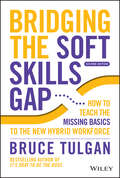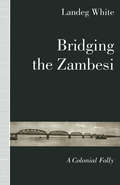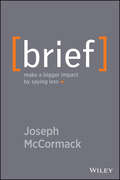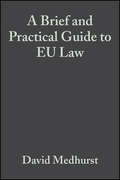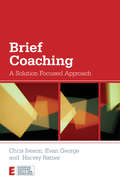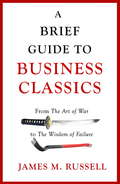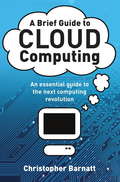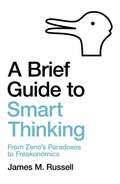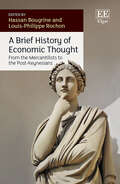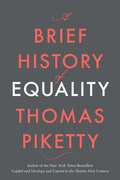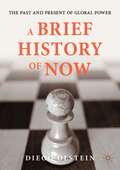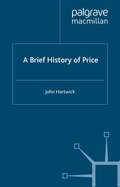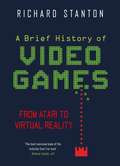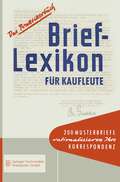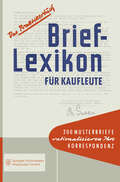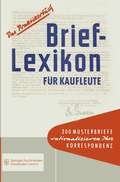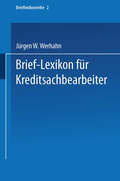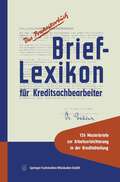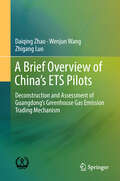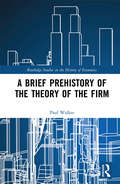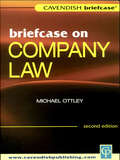- Table View
- List View
Bridging the Soft Skills Gap: How to Teach the Missing Basics to the New Hybrid Workforce
by Bruce TulganNurture and develop well-rounded team players by focusing on soft skills development People entering the professional world are better educated than ever before. Their technical skills are often off-the-charts, helping them make short work of even the most challenging tasks. At the same time, however, many of these very same people lack soft skills we&’ve often taken for granted. In the newly revised second edition of Bridging the Soft Skills Gap: How to Teach the Missing Basics to the New Hybrid Workforce, veteran business advisor, speaker, and consultant Bruce Tulgan delivers a practical and incisive roadmap to developing crucial professionalism, critical thinking, and teamwork skills. You&’ll also find: A collection of 92 instructive lesson plans designed to break soft skills down into their component parts and teach them one manageable piece at a time An exploration of the soft skills gap, including what it means and how its impact on your organization will be felt Explanations of why you can&’t hire your way around a soft skills gapAn essential leadership handbook for executives, managers, and other business leaders, Bridging the Soft Skills Gap is a must-read resource for human resources professionals, team leaders, and front-line employees who deal with promising, but unpolished, talent.
Bridging the Zambesi: A Colonial Folly
by Landeg WhiteIn 1935, a bridge was opened across the Zambesi delta in Portuguese East Africa. 51 years later, it was blown up by anti-government forces. This book brings together politics, diplomacy, economics, labour history and technology to show how this engineering feat was a disaster of colonial planning.
Brief: Make a Bigger Impact by Saying Less
by Joseph McCormackGet heard by being clear and concise The only way to survive in business today is to be a lean communicator. Busy executives expect you to respect and manage their time more effectively than ever. You need to do the groundwork to make your message tight and to the point. The average professional receives 304 emails per week and checks their smartphones 36 times an hour and 38 hours a week. This inattention has spread to every part of life. The average attention span has shrunk from 12 seconds in 2000 to eight in 2012. So, throw them a lifeline and be brief. Author Joe McCormack tackles the challenges of inattention, interruptions, and impatience that every professional faces. His proven B.R.I.E.F. approach, which stands for Background, Relevance, Information, Ending, and Follow up, helps simplify and clarify complex communication. BRIEF will help you summarize lengthy information, tell a short story, harness the power of infographics and videos, and turn monologue presentations into controlled conversations. Details the B.R.I.E.F. approach to distilling your message into a brief presentation Written by the founder and CEO of Sheffield Marketing Partners, which specializes in message and narrative development, who is also a recognized expert in Narrative Mapping, a technique that helps clients achieve a clearer and more concise message Long story short: BRIEF will help you gain the muscle you need to eliminate wasteful words and stand out from the rest. Be better. Be brief.
Brief: Make a Bigger Impact by Saying Less
by Joseph McCormackGet heard by being clear and concise The only way to survive in business today is to be a lean communicator. Busy executives expect you to respect and manage their time more effectively than ever. You need to do the groundwork to make your message tight and to the point. The average professional receives 304 emails per week and checks their smartphones 36 times an hour and 38 hours a week. This inattention has spread to every part of life. The average attention span has shrunk from 12 seconds in 2000 to eight in 2012. So, throw them a lifeline and be brief. Author Joe McCormack tackles the challenges of inattention, interruptions, and impatience that every professional faces. His proven B.R.I.E.F. approach, which stands for Background, Relevance, Information, Ending, and Follow up, helps simplify and clarify complex communication. BRIEF will help you summarize lengthy information, tell a short story, harness the power of infographics and videos, and turn monologue presentations into controlled conversations. Details the B.R.I.E.F. approach to distilling your message into a brief presentation Written by the founder and CEO of Sheffield Marketing Partners, which specializes in message and narrative development, who is also a recognized expert in Narrative Mapping, a technique that helps clients achieve a clearer and more concise message Long story short: BRIEF will help you gain the muscle you need to eliminate wasteful words and stand out from the rest. Be better. Be brief.
A Brief and Practical Guide to EU Law
by David MedhurstThis book is designed to be a quick guide to European Union law and explains how it may be used for practical effect. It is written in a clear style for practitioners who are in a hurry to master the subject, and contains precedents of the kinds of documents they may have to prepare. It explains the basic law, the basic concepts, the procedure and the jargon in a way that lawyers new to the subject will find easy to understand. It will give them the answers they need fast. Throughout, there is extensive reference to case law. The new edition has been revised to take into account the 1997 Amsterdam Treaty, which consolidated and renumbered the articles of the Union Treaty and incorporated the Social Charter. It also covers recent case law and changes to competition law.
Brief Coaching: A Solution Focused Approach (Essential Coaching Skills and Knowledge)
by Chris Iveson Evan George Harvey RatnerBrief Coaching offers a new approach to coaching by considering how the client will know when they have reached their goal, and what they are already doing to get there. The coach aims to work towards the solution rather than working away from the problem, so that the client's problem is not central to the session, but instead the coach and the client work towards the client's preferred future. This book employs case examples and transcripts of sessions to offer guidance on: looking for resources rather than deficits exploring possible and preferred futures examining what is already contributing to that future treating clients as experts in all aspects of their lives. This practical guide includes summaries and activities for the coach to do with the client and will therefore be a useful tool for both new and experienced coaches, as well as therapists branching into coaching who want to add to their existing skills.
Brief Coaching: A Solution Focused Approach (Essential Coaching Skills and Knowledge)
by Chris Iveson Evan George Harvey RatnerBrief Coaching offers a new approach to coaching by considering how the client will know when they have reached their goal, and what they are already doing to get there. The coach aims to work towards the solution rather than working away from the problem, so that the client's problem is not central to the session, but instead the coach and the client work towards the client's preferred future. This book employs case examples and transcripts of sessions to offer guidance on: looking for resources rather than deficits exploring possible and preferred futures examining what is already contributing to that future treating clients as experts in all aspects of their lives. This practical guide includes summaries and activities for the coach to do with the client and will therefore be a useful tool for both new and experienced coaches, as well as therapists branching into coaching who want to add to their existing skills.
A Brief Guide to Business Classics: From The Art of War to The Wisdom of Failure
by James M. RussellThe world of business books is a curious place where one can find everyone from great businesspeople like Warren Buffett, Steve Jobs and Elon Musk, to the most spectacular business failures such as Enron and the sub-prime business market. There are geniuses, hard workers, academics and entrepreneurs as well a few charlatans and hucksters. There's even room for Donald Trump. The 70 titles covered were chosen with various parameters in mind: to cover a range of areas of business, from sales and marketing to negotiation, entrepreneurship to investing, leadership to innovation, and from traditional and corporate models of business to start-up manuals and alternative angles on the subject. Obvious bestselling titles such as How to Make Friends and Influence People or 7 Habits of Highly Effective People have been included, but there are also those books of more questionable value often included on recommended lists of business classics, included here by way of warning. The chosen books also cover a wide span of time and acknowledge that some of the most powerful or entertaining insights into business can be found in texts that aren't perceived as being 'business books', for instance The Art of War, Microserfs, Thinking Fast and Slow and The Wealth of Nations. The selection includes a good range of the most recent successes in business publishing with which readers may be less familiar. The titles are arranged chronologically, allowing the reader to dip in, but also casting an intriguing light on how trends in business titles have changed over the years. Among these titles, you will find expert advice, based on solid research (for instance The Effective Executive or Getting to Yes), and inspirational guides to setting up businesses and running them on sound foundations (such as True North, Crucial Conversations, or We) alongside dubious management manuals that take a single flawed idea and stretch it out to the point of absurdity. The hope is that the reader will be inspired to read the best of these titles, ignore the worst of them, and will come away with at least a basic idea of what each has to teach us about business.
A Brief Guide to Cloud Computing: An essential guide to the next computing revolution. (Brief Histories)
by Christopher BarnattAn accessible and comprehensive guide to the future of computing.Cloud Computing is the next computing revolution and will have as much impact on your life as the introduction of the PC. Using websites including Facebook, Flickr and Gmail, many people already store some information out in the Internet cloud. However, within a few years most computing applications will be accessed online with the web at the heart of everything we do.In this valuable guide, expert Christopher Barnatt explains how computing will rapidly become more reliable, less complex, and more environmentally friendly. He explores online software and hardware, and how it will alter our office work and personal lives. Individuals and companies are going to be released from the constraints of desktop computing and expensive corporate data centres. New services like augmented reality will also become available.Including coverage of Google Docs, Zoho, Microsoft Azure, Amazon EC2 and other key developments, this book is your essential guide to the cloud computing revolution.
A Brief Guide to Smart Thinking: From Zeno’s Paradoxes to Freakonomics
by James M. RussellEach book is summarised to convey a brief idea of what each one has to offer the interested reader, while a 'Speed Read' for each book delivers a quick sense of what each book is like to read and a highly compressed summary of the main points of the book in question. The titles covered include thought-provoking classics on psychology, mindfulness, rationality, the brain, mathematical and economic thought and practical philosophy. The selection includes books about self-improvement as well as historically interesting accounts of how the mind works. Titles included go back as far as the Epictetus classic The Enchiridion and Bertrand Russell's charming The ABC of Relativity, and proceed through classics such as Edward de Bono's Lateral Thinking and into the digital era with titles such as The Shallows and Big Data. The books are arranged chronologically, which draws attention to some of the interesting juxtapositions and connections between them. Some of the titles included are: Freakonomics, by Steven D. Levitt; Blink: The Power of Thinking Without Thinking, by Malcolm Gladwell; Sapiens: A Brief History of Humankind, by Yuval Noah Harari; The Organized Mind: Thinking Straight in the Age of Information Overload, by Daniel J. Levitin; The Descent of Man, by Grayson Perry; How the Mind Works, by Steven Pinker; Black Box Thinking: Why Some People Never Learn from Their Mistakes - But Some Do, by Matthew Syed; We Should All Be Feminists, by Chimamanda Ngozi Adichie; Guns, Germs, and Steel: The Fates of Human Societies, by Jared Diamond; The Black Swan: The Impact of the Highly Improbable, by Nassim Nicholas Taleb; Man's Search for Meaning, by Viktor E. Frankl; The News: A User's Manual, by Alain de Botton; Mindware: Tools for Smart Thinking, by Richard E. Nisbett; The ABC of Relativity, by Bertrand Russell; The Psychopath Test, by Jon Ronson; The Path: What Chinese Philosophers Can Teach Us About the Good Life, by Michael Puett; A Brief History of Time, by Stephen Hawking; Messy: The Power of Disorder to Transform Our Lives, by Tim Harford; Big Data: A Revolution That Will Transform How We Live, Work, and Think, by Viktor Mayer-Schönberger; Moneyball: The Art of Winning an Unfair Game, by Michael Lewis; The Survivors Club: The Secrets and Science That Could Save Your Life, by Ben Sherwood; Black Box Thinking, by Matthew Syed; Chaos: Making a New Science, by James Gleick; A Short History of Nearly Everything, by Bill Bryson; The Shallows: What the Internet Is Doing to Our Brains, by Nicholas Carr; Making Ideas Happen: Overcoming the Obstacles Between Vision and Reality, by Scott Belsky; The Enchiridion, by Epictetus; Gödel, Escher, Bach, by Douglas R. Hofstadter; What I Talk About When I Talk About Running, by Haruki Murakami; and Lateral Thinking, by Edward de Bono.
A Brief History of Economic Thought: From the Mercantilists to the Post-Keynesians
It is now widely acknowledged that history is useful, even essential, because it helps us predict the future. The history of ideas in economics, as in other fields of inquiry, plays an important role in enlightening current researchers as they endeavour to understand contemporary events and anticipate the future of human societies. This book brings together a fine collection of chapters that span contributions from forgotten classics to the most recent new thinking about critical issues such as growth, wealth, its creation and its distribution among members of society. It is A Brief History of Economic Thought, but it will certainly go a long way in helping undergraduate students and other researchers who are curious about the evolution of economic ideas over the last five centuries. Chapters offer discussions on the main tenets of post-Keynesian economics, and focus on issues of growth, wealth and income distribution. The debate on the role of government versus the market is brought to the fore within the context of economic thought from the Physiocrats to the post-Keynesians.The editors have created an essential read for scholars and students interested in the history of economic thought and post-Keynesian economics.
A Brief History of Equality
by Thomas PikettyThe world’s leading economist of inequality presents a short but sweeping and surprisingly optimistic history of human progress toward equality despite crises, disasters, and backsliding. A perfect introduction to the ideas developed in his monumental earlier books. It’s easy to be pessimistic about inequality. We know it has increased dramatically in many parts of the world over the past two generations. No one has done more to reveal the problem than Thomas Piketty. Now, in this surprising and powerful new work, Piketty reminds us that the grand sweep of history gives us reasons to be optimistic. Over the centuries, he shows, we have been moving toward greater equality. Piketty guides us with elegance and concision through the great movements that have made the modern world for better and worse: the growth of capitalism, revolutions, imperialism, slavery, wars, and the building of the welfare state. It’s a history of violence and social struggle, punctuated by regression and disaster. But through it all, Piketty shows, human societies have moved fitfully toward a more just distribution of income and assets, a reduction of racial and gender inequalities, and greater access to health care, education, and the rights of citizenship. Our rough march forward is political and ideological, an endless fight against injustice. To keep moving, Piketty argues, we need to learn and commit to what works, to institutional, legal, social, fiscal, and educational systems that can make equality a lasting reality. At the same time, we need to resist historical amnesia and the temptations of cultural separatism and intellectual compartmentalization. At stake is the quality of life for billions of people. We know we can do better, Piketty concludes. The past shows us how. The future is up to us.
A Brief History of Now: The Past and Present of Global Power
by Diego OlsteinExploring the rise and fall of global power from the mid-nineteenth century, this book tracks the long and interrelated trajectories of the most serious challenges facing the world today. Although at first the urgency of the coronavirus outbreak in 2020 seemed to take precedence over other global problems such as socioeconomic inequality and climate change, it has ultimately exacerbated these issues and created opportunities to address them boldly and innovatively. A Brief History of Now provides a bird’s-eye view of world hegemony, economic globalization and political regimes as they have evolved and developed over the last two hundred years, providing context and insights into the forces which have shaped the Western world. Presented in an accessible and engaging narrative, the book addresses key contemporary challenges and explores the repercussions of a technological revolution, the potential instability of democracy over the coming years, and the urgent struggle to tackle climate change. With his book, Diego Olstein helps to answer pressing questions about our world today and provides a roadmap for analysing future trajectories.
A Brief History of Price
by J. HartwickThis book is an attempt to explain to the layperson what contemporary economics is about. It starts on the assumption that most economics is just refined common sense and clearly explains the key ideas associated with each issue. All the main topics of academic economics are considered: the theory of individual choice, the labour market, the competition between firms, international trade, economic growth, the stock market, unemployment, and money. The general principles are sketched first without maths or diagrams, and then discussed in the context of topical problems such as the collapse of communism in Eastern Europe, the lack of development in the third-world countries, the contrast between market forces and the protection of the environment, showing how economics is not necessarily a dry academic pursuit.
A Brief History Of Video Games: From Atari to Virtual Reality (Brief Histories)
by Rich Stanton'Stanton writes with terrific verve and precision . . . his understanding of the seductive pleasures of gaming takes us right to its heart.'Maria Bustillos, Times Literary Supplement'The best overview book of the industry that I've read.'Andrew Liptak, io9From the first wood-panelled Pong machines in California to the masterpieces of engineering that now sit in countless homes all over the world, A Brief History of Video Games reveals the vibrant history and culture of interactive entertainment. Above all, this is a book about the games - how the experience of playing has developed from simple, repetitive beginnings into a cornucopia of genres and styles, at once utterly immersive and socially engaging. With full-colour illustrations throughout, it shows how technological advances have transformed the first dots and dashes of bored engineers into sophisticated, responsive worlds that are endlessly captivating. As thrilling and surprising as the games it describes, this is an indispensable read for anyone serious about the business of having fun.
Brief-Lexikon für Kaufleute: Ein Handbuch für die rationelle Erledigung der Korrespondenz (Brief-Lexikon-Reihe)
by Betriebswirtschafts-MagazinBrief-Lexikon für Kaufleute: Ein Handbuch für rationelle Erledigung der Korrespondenz (Brief-Lexikon-Reihe)
by Betriebswirtschafts-MagazinBrief-Lexikon für Kaufleute: Ein Handbuch für die rationelle Erledigung der Korrespondenz (Brief-Lexikon-Reihe)
by Schrifleitung des Wirtschafts-MagazinsBrief-lexikon für Kaufleute: Ein Handbuch für die rationelle Erledigung der Korrespondenz (Brief-Lexikon-Reihe)
by Verlag Dr. Th. Gabler GmbHBrief-Lexikon für Kreditsachbearbeiter: Ein Handbuch für die bankmäßige Kreditbearbeitung (Brief-Lexikon-Reihe)
by Jürgen W. WerhahnBrief-Lexikon für Kreditsachbearbeiter: Ein Handbuch für die bankmäßige Kreditbearbeitung (Brief-Lexikon-Reihe)
by Jürgen W. WerhahnA Brief Overview of China’s ETS Pilots: Deconstruction and Assessment of Guangdong’s Greenhouse Gas Emission Trading Mechanism
by Daiqing Zhao Wenjun Wang Zhigang LuoThis book systematically introduces readers to the framework of China’s ETS pilots, exploring their design and operating process, the current state of the carbon market, and various barriers encountered. To do so, it deconstructs the Guangdong ETS, which is the largest and most representative of China’s seven ETS pilots. The book subsequently describes and evaluates all seven pilots in terms of their efficiency, macro and micro effects, the method involved in the DEA model, the CGE model, and cost-benefit analysis. In turn, in the assessment section it demonstrates how some ETS pilots have failed to control carbon emissions due to inordinately high emissions quotas issued by the local government etc. Further, it argues that ETS should focus on those industries with large emissions and high mitigating potential for the time being, and then gradually expand the scale of its coverage.As China’s national ETS is slated for launch on the basis of the lessons learned from the ETS pilots, the book offers a timely and valuable resource for all those who want to understand and forecast the development of China’s ETS. It includes a wealth of descriptions and explanations of Chinese government policies involving carbon emissions control, making it a unique resource.
A Brief Prehistory of the Theory of the Firm (Routledge Studies in the History of Economics)
by Paul WalkerThe theory of the firm did not exist, in any serious manner, until around 1970. Only then did the current theory of the firm literature begin to emerge, based largely upon the work of Ronald Coase and to a lesser degree Frank Knight. It was work by Armen Alchian, Robert Crawford, Harold Demsetz, Michael Jensen, Benjamin Klein, William Meckling and Oliver Williamson, among others, that drove the upswing in interest in the firm among mainstream economists. This accessible book provides a valuable overview of the ‘prehistory’ of the firm. Spanning an impressive timeline, it delves into Antiquity, the Medieval era, the pre-classical economics period and the 19th and 20th centuries. Next, the book traces the theoretical contributions from pre-classical, classical and neoclassical economics. It will be illuminating reading for students and researchers of the history of economic thought, industrial organization, microeconomic theory and business history.
A Brief Prehistory of the Theory of the Firm (Routledge Studies in the History of Economics)
by Paul WalkerThe theory of the firm did not exist, in any serious manner, until around 1970. Only then did the current theory of the firm literature begin to emerge, based largely upon the work of Ronald Coase and to a lesser degree Frank Knight. It was work by Armen Alchian, Robert Crawford, Harold Demsetz, Michael Jensen, Benjamin Klein, William Meckling and Oliver Williamson, among others, that drove the upswing in interest in the firm among mainstream economists. This accessible book provides a valuable overview of the ‘prehistory’ of the firm. Spanning an impressive timeline, it delves into Antiquity, the Medieval era, the pre-classical economics period and the 19th and 20th centuries. Next, the book traces the theoretical contributions from pre-classical, classical and neoclassical economics. It will be illuminating reading for students and researchers of the history of economic thought, industrial organization, microeconomic theory and business history.
Briefcase on Company Law (Briefcase Series)
by MIchael OttleyThe Briefcase series is designed specifically with the time-pressed student in mind. It provides concise case summaries within each subject area of an undergraduate law degree, accompanied by relevant legislation. A handy reference tool, the book assists the reader to commit the content of each subject to memory. This title covers the four main areas of company law: the constitution, formation and personality of a company; corporate governance; corporate finance; and insolvency and company charges. The second edition has been updated to include recent important cases, including the House of Lords decision in Johnson v Gore Wood - (minority shareholder action) Phillips v Brewin Dolphin Bell Lawrie Ltd - (transactions at an undervalue) O'Neill v Phillips - (unfair prejudicial conduct) Williams v Natural Life Health Foods Ltd - (liability in negligence) the Privy Council decision in Agnew v Commissioner of Inland Revenue - (company charges).
